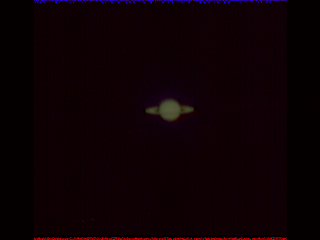I took a few avi's using each of the 2 scopes. I normally wouldnt post images like this, but I thought I'd put em up just as a comparison.
The first is from the reflector. I just could not get good focus. I checked and made some slight adjustments to the collimation, and star testing showed it to be pretty close. I did make some small adjustments however. Anyway, here is the sample image from the reflector: As you can see, the focus is terrible. Some of this could be in the clock drive. By looking at this image, I am thinking that much of the blur came from the clock drive. You can see blur below the image.
Star testing does show a decent pinpoint in focus, and equal appearance inward and outward focus.
This is from the 70mm refractor. Because of the lower amount of light captured with these telescopes, I had to run up the gain in the cameras to get an image, and I did not take a flat to get rid of the diagonal lines. I am seeing the dark northern band and maybe the Cassini, but its difficult to tell, as the diagonal lines produced from the camera makes it hard to tell if I actually resolved it or not. Seeing appeared to be pretty good, as the stars were quite steady, and the sky seemed reasonably transparent tonight. So anyway, here is a comparison using the smaller scopes. There are a number of photos already on here to compare to the 127mm.


























